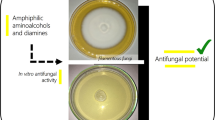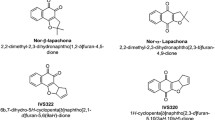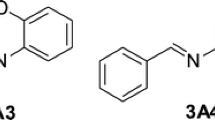Abstract
Dermatophytes are the etiological agents of cutaneous mycoses, including the prevalent nail infections and athlete’s foot. Candida spp. are opportunistic and emerging pathogens, causing superficial to deeper infections related to high mortality rates. As a consequence of prolonged application of antifungal drugs, the treatment failures combined with multidrug-resistance have become a serious problem in clinical practice. Therefore, novel alternative antifungals are required urgently. δ-Lactones have attracted great interest owing to their wide range of biological activity. This article describes the antifungal activity of synthetic δ-lactones against yeasts of the genus Candida spp. and dermatophytes (through the broth microdilution method), discusses the pathways by which the compounds exert this action (toward the fungal cell wall and/or membrane), and evaluates the toxicity to human leukocytes and chorioallantoic membrane (by the hen’s egg test-chorioallantoic membrane). Two of the compounds in the series presented broader spectrum of antifungal activity, including against resistant fungal species. The mechanism of action was related to damage in the fungal cell wall and membrane, with specific target action dependent on the type of substituent present in the δ-lactone structure. The damage in the fungal cell was corroborated by electron microscopy images, which evidenced lysed and completely altered cells after in vitro treatment with δ-lactones. Toxicity was dose dependent for the viability of human leukocytes, but none of the compounds was mutagenic, genotoxic, or membrane irritant when evaluated at higher concentrations than MIC. In this way, δ-lactones constitute a class with excellent perspectives regarding their potential applications as antifungals.



Similar content being viewed by others
References
Batista BG, Dalla Lana DF, Silveira GP, Sá MM, Ferreira M, Russo TVC, Canto RFS, Barbosa FAR, Braga AL, Kaminski TFA, de Oliveira LFS, Machado MM, Lopes W, Vainstein MH, Teixeira ML, de Andrade SF, Fuentefria AM (2017) Allylic selenocyanates as new agents to combat Fusarium species involved with human infections. ChemistrySelect 2:11926–11932
Berkow EL, Lockhart SR (2017) Fluconazole resistance in Candida species: a current perspective. Infect Drug Resist 10:237–245
Burow ME, Weldon CB, Tang Y, Navar GL, Krajewski S, Reed JC, Hammons TG, Clejan S, Beckman BS (1998) Differences in susceptibility to tumor necrosis factor alpha-induced apoptosis among MCF-7 breast cancer cell variants. Cancer Res 44:4940–4946
Carrasco H, Raimondi M, Svetaz L, Liberto MD, Rodriguez MV, Espinoza L, Madrid A, Zacchino S (2012) Antifungal activity of eugenol analogues. Influence of different substituents and studies on mechanism of action. Molecules 17:1002–1024
CLSI (2008a) Reference method for broth dilution antifungal susceptibility testing of yeasts. Approved Standard – Third Edition. CLSI document M27-A3. Clinical and Laboratory Standards Institute, Wayne
CLSI (2008b) Reference method for broth dilution antifungal susceptibility testing of filamentous fungi. Approved Standard – Second Edition. CLSI document M38-A2. Clinical and Laboratory Standards Institute, Wayne
CLSI (2012) Reference method for broth dilution antifungal susceptibility testing of yeasts. Fourth Informational Supplement. CLSI document M27-S4. Clinical and Laboratory Standards Institute, Wayne
Dahdah MJ, Scher RK (2008) Dermatophytes. Curr Fungal Infect Rep 2:8–86
Dalla Lana DF, Batista BG, Alves SH, Fuentefria AM (2016) Dermatophytoses: etiological agents, clinical forms, therapy and new perspectives of treatment. Clin Biomed Res 36:230–241
Eggimann P, Garbino J, Pittet D (2003) Epidemiology of Candida species infections in critically ill non-immunosuppressed patients. Lancet Infect Dis 3:685–702
El Hage S, Lajoie B, Feuillolay C, Roques C, Baziard G (2011) Synthesis, antibacterial and antifungal activities of bifonazole derivatives. Arch Pharm (Weinheim) 344:402–410
Espinel-Ingroff A, Fothergill A, Peter J, Rinaldi MG, Walsh TJ (2002) Testing conditions for determination of minimum fungicidal concentrations of new and established antifungal agents for Aspergillus spp.: NCCLS collaborative study. J Clin Microbiol 40:3204–3208
Fernández-García R, de Pablo E, Ballesteros MP, Serrano DR (2017) Unmet clinical needs in the treatment of systemic fungal infections: the role of amphotericin B and drug targeting. Int J Pharm 525:139–148
Ferreira M, Bisol TB, Conceição HP, Russo TVC, Bortoluzzi AJ, Sá MM (2017) One-pot synthesis of α-ylidene δ-lactones from functionalized allylic bromides in a water–isopropanol medium. Synthesis 49:667–676
Frost DJ, Brandt KD, Cugier D, Goldman R (1995) A whole-cell Candida albicans assay for the detection of inhibitors towards fungal cell wall synthesis and assembly. J Antibiot 48:306–310
Fuentefria AM, Pippi B, Dalla Lana DF, Donato KK, de Andrade SF (2018) Antifungals discovery: an insight into new strategies to combat antifungal resistance. Lett Appl Microbiol 66:2–13
Ghannoum M (2016) Azole resistance in dermatophytes: prevalence and mechanism of action. J Am Podiatr Med Assoc 106:79–86
Guinea J (2014) Global trends in the distribution of Candida species causing candidemia. Clin Microbiol Infect 20:5–10
ICCVMA (Interagency Coordinating Committee on the Validation of Alternative Methods) (2010) The hen's egg test–chorioallantoic membrane (HET-CAM) test method. Research Triangle Park: National Toxicology Program. https://ntp.niehs.nih.gov/iccvam/docs/protocols/ivocularhetcam.pdf
Jackson JE (2003) A user’s guide to principal components. Wiley, Hoboken https://pdfs.semanticscholar.org/70a9/769e8027b48bce5a9ce3a82d0ce88e0f0730.pdf
Janecka A, Wirebska A, Gach K, Fichna J, Janecki T (2012) Natural and synthetic α-methylenelactones and α-methylenelactams with anticancer potential. Drug Discov Today 17:561–572
Kishimoto N, Sugihara S, Mochida K, Fujita T (2005) In vitro antifungal and antiviral activities α -and δ-lactone analogs utilized as food flavoring. Biocontrol Sci 10:31–36
Kuriyama T, Williams DW, Bagg J, Coulter WA, Ready D, Lewis MA (2005) In vitro susceptibility of oral Candida to seven antifungal agents. Oral Microbiol Immunol 20:349–353
Martinez-Rossi N, Peres N, Rossi A (2008) Antifungal resistance mechanisms in dermatophytes. Mycopathologia 166:369–383
Modranka J, Albrecht A, Jakubowski R, Krawczyk H, Zalski MR, Krajewska U, Janecka A, Wyre A, Zalska BR, Janecki T (2012) Synthesis and biological evaluation of α-methylidene-δ-lactones with 3,4-dihydrocoumarin skeleton. Bioorg Med Chem 20:5017–5026
Montagner GFS, Sagrillo M, Machado MM, Almeida RC, Mostardeiro CP, Duarte MP, da Cruz IB (2014) Toxicological effects of ultraviolet radiation on lymphocyte cells with different manganese superoxide dismutase Ala16Val polymorphism genotypes. Toxicol in Vitro 24:1410–1416
Naglik JR, Richardsson JP, Moyes DL (2014) Candida albicans pathogenicity and epithelial immunity. PLoS Pathog 10:1–4
Ohkuma H, Naruse N, Nishiyama Y, Tsuno T, Hoshino Y, Sawada Y, Konishi M, Oki T (1992) Sultriecin, a new antifungal and antitumor antibiotic from Streptomyces roseiscleroticus. Production, isolation, structure and biological activity. J Antibiot 45:1239–1249
Parker JE, Warrilow AG, Price CL, Mullins JG, Kelly DE, Kelly SL (2014) Resistance to antifungals that target CYP51. J Chem Biol 7:143–161
Pfaller MA, Rhomberg PR, Messer SA, Jones RN, Castanheira M (2015) Isavuconazole, micafungin, and 8 comparator antifungal agents’ susceptibility profiles for common and uncommon opportunistic fungi collected in 2013: temporal analysis of antifungal drug resistance using CLSI species-specific clinical breakpoints and proposed epidemiological cutoff values. Diagn Microbiol Infect Dis 82:303–313
Pippi B, Lopes W, Reginatto P, Silva FEK, Joaquim AR, Alves RJ, Silveira GP, Vainstein MH, Andrade SF, Fuentefria AM (2018) New insights into the mechanism of antifungal action of 8-hydroxyquinolines. Saudi Pharm J 2018. https://doi.org/10.1016/j.jsps.2018.07.017.j
Rocha DFS, Sa LFR, Pinto ACC, Junqueira ML, Silva EM, Borges RM, Ferreira-Pereira A (2018) Characterization of an ABC transporter of a resistant Candida glabrata clinical isolate. Mem Inst Oswaldo Cruz 113:1–7
Romero-Guido C, Belo I, Ta TMN, Cao-Hoang L, Alchihab M, Gomes N, Thonart P, Teixeira JÁ, Destain J, Waché Y (2011) Biochemistry of lactone formation in yeast and fungi and its utilisation for the production of flavor and fragrance compounds. Appl Microbiol Biotechnol 89:535–547
Santos RB, Júnior VL, Castro EVR, Balthar VO, Greco SJ (2009) Uso de métodos quimiométricos e mecânicoquanticos na análise de terpenóides e fenilpropanóides bioativos contra o Aedes aegypti. Orbital: Electron J Chem 4:273–288
Silveira GP, Ferreira M, Fernandes L, Moraski GC, Cho S, Hwang C, Franzblau SG, Sá MM (2012) Allylic thiocyanates as a new class of antitubercular agents. Bioorg Med Chem Lett 22:6486–6489
Singh NP, McCoy MT, Tice RR, Schneider EL (1988) A simple technique for quantitation of low levels of DNA damage in individual cells. Exp Cell Res 175:184–191
Tanaka H, Kageyama K, Yoshimura N, Asada R, Kusumoto K, Miwa N (2007) Anti-tumor and anti-invasive effects of diverse delta-alkyllactones: dependence on molecular side-chain length, action period and intracellular uptake. Life Sci 80:1851–1855
Tavares LC (2004) QSAR: Hansch's approach. Quim Nova 27:631–639
Thomas P, Harvey S, Gruner T, Fenech M (2008) The buccal cytome and micronucleus frequency is substantially altered in Down’s syndrome and normal ageing compared to young healthy controls. Mutat Res 638:37–47
Topliss JG (1996) Lipophilicity in drug action and toxicology (book review). J Med Chem 39:5287–5288
Umezawa I, Komiyama K, Oka H, Okada K, Tomisaka S, Miyano T, Takano S (1984) A new antitumor antibiotic, kazusamycin. J Antibiot 37:706–711
Vieira JN, Feijó AM, Bueno ME, Gonçalves CL, Lund RG, Mendes JF, Villarreal JPV, Villela MM, Nascente OS (2018) Evaluation of the frequency of Candida spp. in hospitalized and non-hospitalized subjects. Braz J Biol 78:644–652
Wani MC, Ronman PE, Lindley JT, Wall ME (1980) Plant antitumor agents. Synthesis and biological activity of camptothecin analogues. J Med Chem 23:554–560
Wenderski TA, Stratton CF, Bauer RA, Kopp F, Tan DS (2015) Principal component analysis as a tool for library design: a case study investigating natural products, brand-name drugs, natural product-like libraries, and drug-like libraries. Methods Mol Biol 1263:225–242
Yamada T, Maeda M, Alshahni MM, Tanaka R, Yaguchi T, Bontems O, Salamin K, Fratti M, Monod M (2017) Terbinafine resistance of Trichophyton clinical isolates caused by specific point mutations in the squalene epoxidase gene. Antimicrob Agents Chemother 61:e00115–e00117
Yang EJ, Kim YS, Chang HC (2011) Purification and characterization of antifungal δ-dodecalactone from Lactobacillus plantarum AF1 isolated from kimchi. J Food Prot 74:651–657
Acknowledgments
The authors are grateful to the Center of Microscopy and Microanalysis-UFRGS for the SEM.
Funding
This work was funded by the Brazilian agencies Coordination for the Improvement of Higher Education Personnel (CAPES, Finance Code 001), National Council for Scientific and Technological Development (CNPq), and Foundation for Research Support of the State of Rio Grande do Sul (FAPERGS; Edital PRONUPEQ 2016). G. P. Silveira received financial support from CAPES-UdelaR bilateral collaboration (grant no. 049-2013). A. M. Fuentefria, M. Apel, and M. M. Sá received PQ fellowships from CNPq.
Author information
Authors and Affiliations
Contributions
Daiane F. Dalla Lana, Ânderson R. Carvalho, and William Lopes conceived, planned, and carried out the experiments. Marcus M. Sá, Theo V. C. Russo, and Gustavo P. Silveira synthesized and characterized the samples. Marilene H. Vainstein, Luciano S. P. Guimarães, Mário L. Teixeira, Luis F.S. de Oliveira, and Michel M. Machado assisted in the toxicological and statistical analyses and in obtaining the images from scanning electron microscopy. Alexandre M. Fuentefria and Saulo F. de Andrade contributed to the interpretation of the results and supervision of all the work. Daiane F. Dalla Lana took the lead in writing the manuscript and performed the general research. All authors provided critical feedback and helped shape the research, analysis, and manuscript.
Corresponding author
Ethics declarations
Conflict of interest
The authors declare that they have no conflicts of interest.
Ethical approval
All procedures performed in studies involving human participants were in accordance with the ethical standards of the institutional and/or national research committee and with the 1964 Helsinki declaration and its later amendments or comparable ethical standards. For this type of study formal consent is not required. All applicable international, national, and/or institutional guidelines for the care and use of animals were followed. All procedures performed in studies involving animals were in accordance with the ethical standards of the institution or practice at which the studies were conducted.
Additional information
Publisher’s note
Springer Nature remains neutral with regard to jurisdictional claims in published maps and institutional affiliations.
Rights and permissions
About this article
Cite this article
Dalla Lana, D.F., Carvalho, Â.R., Lopes, W. et al. Structure-based design of δ-lactones for new antifungal drug development: susceptibility, mechanism of action, and toxicity. Folia Microbiol 64, 509–519 (2019). https://doi.org/10.1007/s12223-018-00675-y
Received:
Accepted:
Published:
Issue Date:
DOI: https://doi.org/10.1007/s12223-018-00675-y




